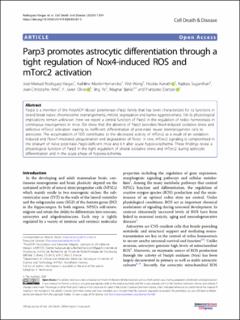| dc.contributor.author | Rodriguez-Vargas, José-Manuel | |
| dc.contributor.author | Martin-Hernandez, Kathline | |
| dc.contributor.author | Wang, Wei | |
| dc.contributor.author | Kunath, Nicolas | |
| dc.contributor.author | Suganthan, Rajikala | |
| dc.contributor.author | Amé, Jean-Christophe | |
| dc.contributor.author | Francisco, Javier Oliver Pozo | |
| dc.contributor.author | Ye, Jing | |
| dc.contributor.author | Bjørås, Magnar | |
| dc.contributor.author | Dantzer, Françoise | |
| dc.date.accessioned | 2020-11-25T13:13:19Z | |
| dc.date.available | 2020-11-25T13:13:19Z | |
| dc.date.created | 2020-11-24T17:40:28Z | |
| dc.date.issued | 2020 | |
| dc.identifier.issn | 2041-4889 | |
| dc.identifier.uri | https://hdl.handle.net/11250/2689582 | |
| dc.description.abstract | Parp3 is a member of the Poly(ADP-ribose) polymerase (Parp) family that has been characterized for its functions in strand break repair, chromosomal rearrangements, mitotic segregation and tumor aggressiveness. Yet its physiological implications remain unknown. Here we report a central function of Parp3 in the regulation of redox homeostasis in continuous neurogenesis in mice. We show that the absence of Parp3 provokes Nox4-induced oxidative stress and defective mTorc2 activation leading to inefficient differentiation of post-natal neural stem/progenitor cells to astrocytes. The accumulation of ROS contributes to the decreased activity of mTorc2 as a result of an oxidationinduced and Fbxw7-mediated ubiquitination and degradation of Rictor. In vivo, mTorc2 signaling is compromised in the striatum of naïve post-natal Parp3-deficient mice and 6 h after acute hypoxia-ischemia. These findings reveal a physiological function of Parp3 in the tight regulation of striatal oxidative stress and mTorc2 during astrocytic differentiation and in the acute phase of hypoxia-ischemia. | en_US |
| dc.language.iso | eng | en_US |
| dc.publisher | Springer Nature | en_US |
| dc.rights | Navngivelse 4.0 Internasjonal | * |
| dc.rights.uri | http://creativecommons.org/licenses/by/4.0/deed.no | * |
| dc.title | Parp3 promotes astrocytic differentiation through a tight regulation of Nox4-induced ROS and mTorc2 activation | en_US |
| dc.type | Peer reviewed | en_US |
| dc.type | Journal article | en_US |
| dc.description.version | publishedVersion | en_US |
| dc.source.journal | Cell Death & Disease | en_US |
| dc.identifier.doi | 10.1038/s41419-020-03167-5 | |
| dc.identifier.cristin | 1851867 | |
| dc.description.localcode | © The Author(s) 2020 This article is licensed under a Creative Commons Attribution 4.0 International License, which permits use, sharing, adaptation, distribution and reproduction in any medium or format, as long as you give appropriate credit to the original author(s) and the source, provide a link to the Creative Commons license, and indicate if changes were made. The images or other third party material in this article are included in the article’s Creative Commons license, unless indicated otherwise in a credit line to the material. If material is not included in the article’s Creative Commons license and your intended use is not permitted by statutory regulation or exceeds the permitted use, you will need to obtain permission directly from the copyright holder. To view a copy of this license, visit http://creativecommons.org/licenses/by/4.0/. | en_US |
| cristin.ispublished | true | |
| cristin.fulltext | original | |
| cristin.qualitycode | 1 | |

